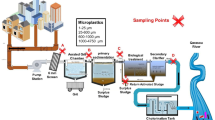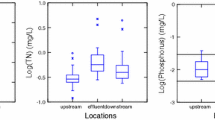Abstract
Waste water treatment on freshwater fish farms is problematic as waste material and water flows can vary greatly on a daily basis, and, in terms of effluent standards, fish farm effluent represents a dilute waste water output. A study was undertaken to investigate in detail the nature of the waste outputs under field conditions. Waste water samples were split by meshes into the following size ranges: >200µm, 200-100µm, 100-60µm, 60-30µm and <30µm. Waste water quality parameters, suspended solids (SS), biochemical oxygen demand (BOD5) and total phosphorus (TP) were examined for each size range at two freshwater fish farm sites in Scotland, as part of a wider investigation into waste water quality of aquaculture operations. Results indicated that during periods of peak waste output i.e. tank cleaning, approximately 80% of BOD5 and SS was present in a particle size range of 100-60µm, but only 66% of TP transport occurred in this size range. At other times, low levels (≤40%) of entrapment of wastes by the chosen meshes was observed, suggesting a reversion to predominantly dissolved material transport. Compared against a larger data set of outflow concentrations obtained from another section of the study, maximum removal rates of 46%, 48% and 30% for BOD5, SS and TP respectively were determined. The implications for waste water treatment at fish farms are discussed.
Similar content being viewed by others
References
Ackefors, H. and Enell, M. (1990) Discharge of nutrients from Swedish fish farming to adjacent sea areas.Ambio 19, 28–35.
APHA (1987)Standard Methods for the Examination of Waters and Wastewaters (17th Edition). American Public Health Association, Washington DC, pp. 1405.
Bergheim, A., Sanni, S., Indrevik, G. and Hølland, P. (1993) Sludge removal from salmonid tank effluent using rotating microsieves.Aquaculture Engineering 12, 97–109.
Cripps, S.J. (1993) The application of suspended particle characterization techniques to aquaculture systems. In:Techniques for Modern Aquaculture (ed J. Wang, 1996) Proceedings of an Aquaculture Engineering Conference, Spokane, Washington, USA. American Society of Agriculture Engineers, St Joseph, Michigan, USA, pp. 26–34.
Cripps, S.J. (1995) Serial particle size fractionation and characterisation of an aquaculture effluent.Aquaculture 133, 323–339.
Cripps, S.J. and Kelly, L.A. (in press). Waste water treatment in aquaculture. In:Aquaculture and Water Resources Management (eds Baird, D.J., Beveridge, M.C.M., Kelly, L.A. and Muir, J.F.), Fishing News Books, Cambridge, England.
Eikebrokk, B. and Ulgenes, Y. (1993) Characterisation of treated and untreated effluents from land-based fish farms. In:Fish Farming Technology, (Eds H. Reinertsen, L.A. Dahle, L. Jørgensen and K. Tvinnereim) Proceedings of the First International Conference on Fish Farming Technology, Trondheim, 9–12 August 1993, Balkema, Rotterdam, pp. 361–366.
Foy, R.H. and Rosell, R. (1991) Fractionation of phosphorus and nitrogen loadings from a Northern Ireland fish farm.Aquaculture 96, 31–42.
Hänel, K. (1988)Biological Treatment of Sewage by the Activated Sludge Process. Ellis Horwood, Chichester, pp. 299.
Henderson, J.P. and Bromage, N.R. (1988) Optimising the removal of suspended solids from aquacultural effluents in settlement lakes.Aquaculture Engineering 7, 167–181.
Hennessy, M.M., Wilson, L., Struthers, W. and Kelly, L.A. (1996) Waste loads from two Atlantic salmon juvenile farms in Scotland.Water, Air, and Soil Pollution 86, 235–249.
HMSO (1981)Phosphorous in Waters, Effluents and Sewages 1980: Methods for the examination of waters and associated materials. HMSO, London, pp. 31.
HMSO (1984)Suspended Settleable and Total Dissolved Solids in Waters and Effluents 1980: Methods for the examination of waters and associated materials. HMSO, London, pp. 27.
HMSO (1989)Five day Biochemical Oxygen Demand (BOD). Second Edition with Dissolved Oxygen Amendments: Methods for the examination of waters and associated materials. HMSO, London, pp. 35.
Kelly, L.A., Bergheim, A. and Hennessy, M.M. (1994) Predicting ammonium outputs from fish farms.Water Research 26, 1403–1405.
Mäkinen, T., Lindgren, S. and Ekelinen, P. (1988) Sieving as an effluent treatment method for aquaculture.Aquacultural Engineering 7, 367–377.
NCC (1990)Fish Farming and the Scottish Freshwater Environment NCC, Edinburgh, Scotland, pp. 285.
Merican, Z.O. and Phillips, M.J. (1985) Solid waste production from rainbow troutSalmo gairdneri Richardson, cage culture.Aquaculture and Fisheries Management 1, 55–69.
Phillips, M.J., Beveridge, M.C.M. and Clarke, R.M. (1991) Impact of aquaculture on water resources. In:Advances in World Aquaculture Volume 3: Aquaculture and Water Quality, (eds Brune, D.E. and Tomasso J.R.) World Aquaculture Society, Baton Rouge, USA, pp. 568–591.
Poxton, M.G. and Allouse, S.B. (1987) Cyclical fluctuations in ammonia and nitrite-nitrogen resulting from the feeding of turbot,Scophthalmus maximus (L), in recirculation systems.Aquaculture Engineering 6, 301–322.
Vissman, W. Jr. and Hammer, M.J. (1992)Water Supply and Pollution Control. Fifth Edition. Harper Collins, New York, pp. 860.
Warrer-Hansen, I. (1982). Methods of treatment of waste water from trout farming. In:EIFAC Technical Paper No.41, (ed J. Alabaster) Report of the EIFAC Workshop on Fish-Farm Effluents, Silkeborg, Denmark, 26–28 May, 1981, FAO Rome, pp. 113–121.
Author information
Authors and Affiliations
Rights and permissions
About this article
Cite this article
Kelly, L.A., Bergheim, A. & Stellwagen, J. Particle size distribution of wastes from freshwater fish farms. Aquacult Int 5, 65–78 (1997). https://doi.org/10.1007/BF02764788
Issue Date:
DOI: https://doi.org/10.1007/BF02764788




